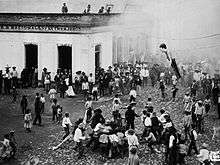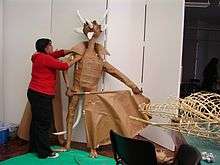Burning of Judas
The burning of Judas is an Easter-time ritual originated in European[1] Christian communities, where an effigy of Judas Iscariot is burned. Other related mistreatment of Judas effigies include hanging, flogging, and exploding with fireworks.[2][3] Anthropologists generalize these types of activities as "scapegoating rituals". A similar ritual in Jewish tradition would be the hanging and burning an effigy of Haman and his ten sons during Purim, although this is not a widespread contemporary practice.[4][5]

Though not an official part of the Easter liturgical cycle, the custom is typically a part of the reenactment of the story of the Passion that is practiced by the faithful during Easter. Customs vary, but the effigy of Judas is typically hanged (reenacting Matthew 27:5) on Good Friday, then burned on the night of Easter Sunday.
In many parts of Latin America this practice occurs on the eve of the New Year as a symbol of ridding one's self of evil and beginning a new year in spiritual purity. Some communities observe this ritual using various effigies, including the biblical Judas (who betrayed Jesus). This custom, during which the effigy is burned on a stake, is called "Quema del Judas" ("the burning of Judas") in Uruguay and Argentina, and "Quema del Año Viejo" ("the burning of the old year")[6] in other places.
Practice
.jpg)

The burning of Judas was once widely practiced across the Christian world in England,[7] Greece,[8] Mexico,[9] Brazil,[10] Portugal,[11] Germany,[12] Austria,[13] Czech Republic,[14] Slovakia,[15] Poland,[16][17][18][19] Spain,[20][21] Uruguay,[22] Venezuela,[23] Chile,[24] Peru,[25] Costa Rica,[26] Cyprus where it is called 'lambratzia',[27] the Philippines,[28] Paraguay—where it is called 'Judas kái',[29] Nigeria,[30] and elsewhere. These folk traditions are still practiced today in many of those countries.[18][31][32]
The Czech tradition of drowning and burning an effigy of Judas (vodění Jidáše) is still practiced in a number of villages in the Pardubice Region. The Czech mint issued a gold coin in 2015 to commemorate this folk custom,[33] which was nominated for UNESCO protection as part of that nation's cultural heritage.[34]
Judas burnings also took place in the district of Dingle, in Liverpool, England, in the early and mid twentieth century, but was often stopped by the police.[35] In Liverpool's South End bands of children still practiced this custom in the late twentieth century. The very last burning of the Judas was in 1971 and was conducted by local legend Alan Rietdyk on waste ground between Prophet Street and Northumberland Street in the Liverpool 8 area. [36] The burning of Judas is not traditional to England, although a very similar custom of burning Catholic rebel Guy Fawkes in effigy exists. The practice of burning an effigy of the Pope Paul V also continues to exist in England, where as many as 50,000 Protestants gather on Bonfire Night in Lewes to observe the festivities.[37]
Antisemitism
The custom of "burning of Judas" (widespread around Greece and sometimes called "burning of the Jew"), as well as its repeated criticism by the Central Board of Jewish Communities in Greece (KIS) and official denunciation by the Greek Orthodox Church is regularly cited in the United States State Department's Religious Freedom Report for Greece.[38]
In Latin America, despite the controversial nature of anti-Semitism associated with the "burning of the Jew" (one of the custom's many monikers), although the practice does exist in the above stated form it is not regarded as an act of hostility towards the Jewish nation or ethnicity but is simply representative of "evil", thus not differing in any way from the other effigies listed.[39]
References
- Pedelty, Mark (2009-06-03). Musical Ritual in Mexico City: From the Aztec to NAFTA. University of Texas Press. ISBN 9780292774186.
- Doane, William Croswell (30 October 2018). "The Book of Easter". Macmillan – via Google Books.
- F.F.T. (1902-02-09). "Lenten Days In Mexico. - Curious Customs To Be Seen This Week In The Land Of Montezuma. - Article - Nytimes.Com". New York Times. Retrieved 2013-03-04.
- Sandrow, Nahma (1996). Vagabond Stars: A World History of Yiddish Theater. Syracuse University Press. ISBN 9780815603290.
Sometimes they went outside the city gates, carrying a dummy representing Haman, whom they hanged in effigy and burned in a bonfire
- Kerler, Dov-Ber (2000-01-01). Politics of Yiddish: Studies in Language, Literature and Society. Rowman Altamira. ISBN 9780585223575.
There is some evidence Of the hanging and burning of the Haman effigy in the midst of song and dance lasting well past the Middle Ages
- es:Año viejo
- Hole, Christina (1976). British folk customs. Hutchinson. p. 38. ISBN 9780091273408.
BURNING JUDAS suit of men's clothes and having a comic mask over its face. It looks very much like the traditional guy of November 5th (see Guy Fawkes Day), but it is supposed to represent Judas Iscariot. When the sun rises, the leader of a ...
- ; "Greek town ritually burned Judas as Orthodox celebrated Easter", https://religionnews.com/2018/04/09/greek-town-ritually-burned-judas-as-orthodox-celebrated-easter/
- Burning of Judas, https://encyclopedia2.thefreedictionary.com/Judas%2C+Burning+of;%22Archived+copy%22.+Archived+from+the+original+on+2005-03-26.+Retrieved+2005-07-11.CS1+maint:+archived+copy+as+title+(link); Judas Burning in Mexico, https://www.mexican-folk-art-guide.com/judas-burning.html#.XMUT2NQrI0M
- Mendes, Carlos Pimentel. "Novo Milênio: Histórias e Lendas de Santos: Malhação do Judas. Quem lembra?". www.novomilenio.inf.br.
- Easter in Portugal - Burning Judas, Burying The Cod, https://www.azores-adventures.com/2016/03/easter-in-portugal-burning-judas-burying-the-cod.html
- "Und ewig brennt der Judas" in: SAUERLAND Zeitschrift des Sauerländer Heimatbundes, Sauerländer Heimatbund 2013, p. 9, http://www.sauerlaender-heimatbund.de/Sauerland_2013_1.pdf Archived 2018-05-01 at the Wayback Machine; Bayerisches Brauchtum bizarr: "Der Jud muß verbrannt werden!", http://www.hagalil.com/2009/04/brauchtum/; "Verbrennt den Judas!",https://www.volksfreund.de/region/vulkaneifel/verbrennt-den-judas_aid-5147747
- Fabulous Easter Events in Vienna and Salzburg, https://www.clcworld.com/articles/fabulous-easter-events-in-vienna-and-salzburg/
- Burning of Judas, https://encyclopedia2.thefreedictionary.com/Judas%2C+Burning+of; Petr Chudoba, Czech Easter - The Chasing and Burning of Judas, http://www.myczechrepublic.com/czech_culture/czech_holidays/easter/judas.html
- Traditions of a Slovak Easter, https://spectator.sme.sk/c/20035854/traditions-of-a-slovak-easter.html
- Urszula Janicka-Krzywda, Wielkotygodniowy obrzęd palenia Judasza w Polsce południowej in: kultura ludowa.pl
- Diana Walawender, Tradycje i zwyczaje wielkanocne. Palenie Judasza in:historia.org.pl
- Bachner, Michael (April 21, 2019). "Polish crowd beats, burns Judas effigy with hat, sidelocks of ultra-Orthodox Jew". Times of Israel.
- Grzegorz Górny, "Who is allowed to burn Judas?", https://rmx.news/poland/who-allowed-burn-judas
- 'The burning of Judas' celebrations during Easter Sunday in La Rioja, http://www.epa.eu/religion-photos/belief-faith-photos/-the-burning-of-judas-celebrations-during-easter-sunday-in-la-rioja-photos-55140027%5B%5D; La Noche de San Juan: The Night of Fire, https://www.livinglanguage.com/blog/2012/06/22/la-noche-de-san-juan-the-night-of-fire/
- Mitchell, Timothy J. (1988). Violence and Piety in Spanish Folklore. University of Pennsylvania Press. ISBN 9780812280937.
- "I remember children in 1930s Liverpool lighting bonfires in the streets early on Good Friday morning and burning Judas. Did these activities take place anywhere else, and are they still going on? | Notes and Queries". www.theguardian.com.
- Burning of Judas, https://encyclopedia2.thefreedictionary.com/Judas%2C+Burning+of
- Judas Doll, Valparaiso, https://melaniehamlett.com/2012/04/15/this-is-the-judas-doll-that-my-neighborhood-torched-on-easter-night-he-was-stuffed-with-coins-so-at-the-end-all-the-little-kids-ran-into-the-fire-and-collected-hot-money-that-probably-scolded-their/; https://www.lonelyplanet.com/thorntree/forums/americas-south-america/topics/semana-santa-in-chile
- Burning of Judas, https://encyclopedia2.thefreedictionary.com/Judas%2C+Burning+of
- Costa Rica Firefighters Wait for the Burning of Judas Iscariot, https://news.co.cr/costa-rica-firefighters-wait-for-the-burning-of-judas-iscariot/45989/
- Archived July 4, 2008, at the Wayback Machine; The Easter tradition that’s becoming an excuse for bad behaviour, https://cyprus-mail.com/2019/04/27/our-view-the-easter-tradition-thats-becoming-an-excuse-for-bad-behaviour/
- Here’s one peculiar Lenten tradition in Antique, https://news.mb.com.ph/2017/04/15/heres-one-peculiar-lenten-tradition-in-antique/
- Is There a Home in Cyberspace? https://books.google.ca/books?id=NsxACqp4PfYC&pg=PA84&lpg=PA84&dq=judas+burning+paraguay&source=bl&ots=PfAQyZG0vL&sig=ACfU3U19IthA9nX8F-BdmyZOxDlpFLkWYw&hl=en&sa=X&ved=2ahUKEwj7jb3A7_HhAhWtc98KHTxdDAIQ6AEwFXoECAUQAQ#v=onepage&q=judas%20burning%20paraguay&f=false
- Burning of Judas, https://encyclopedia2.thefreedictionary.com/Judas%2C+Burning+of
- "WATCH: Greeks celebrate Orthodox Easter by burning effigy of Judas". News24. 2019-04-29. Retrieved 2019-05-01.
- Fabulous Easter Events in Vienna and Salzburg, https://www.clcworld.com/articles/fabulous-easter-events-in-vienna-and-salzburg/
- "Zvyk vodění Jidáše se stal nehmotným kulturním dědictvím", https://www.idnes.cz/pardubice/zpravy/vodeni-jidase-na-seznam-nematerialnich-statku-tradicni-a-lidove-kultury.A121218_150143_pardubice-zpravy_pri; Zlatá mince České tradice UNESCO - Vodění Jidáše proof, https://ceskamincovna.cz/zlata-mince-ceske-tradice-unesco---vodeni-jidase-proof-456-8730-d "Vodění Jidáše", http://www.nulk.cz/2017/01/30/vodeni-jidase
- "UNESCO".
- BBC. "Judas Burning".
- "Judas, Burning of".
- Sandro Contenta, “Fiery ritual ignites passions: English town clings to ancient practice of burning effigy of pope in its blazing celebration of Bonfire Night,” Toronto Star, November 4, 2006
- "Greece".
- ":: Bienvenidos al web de Rodolfo Pérez Pimentel - Escritor Ecuatoriano ::". www.ecuadorprofundo.com.
.jpg)